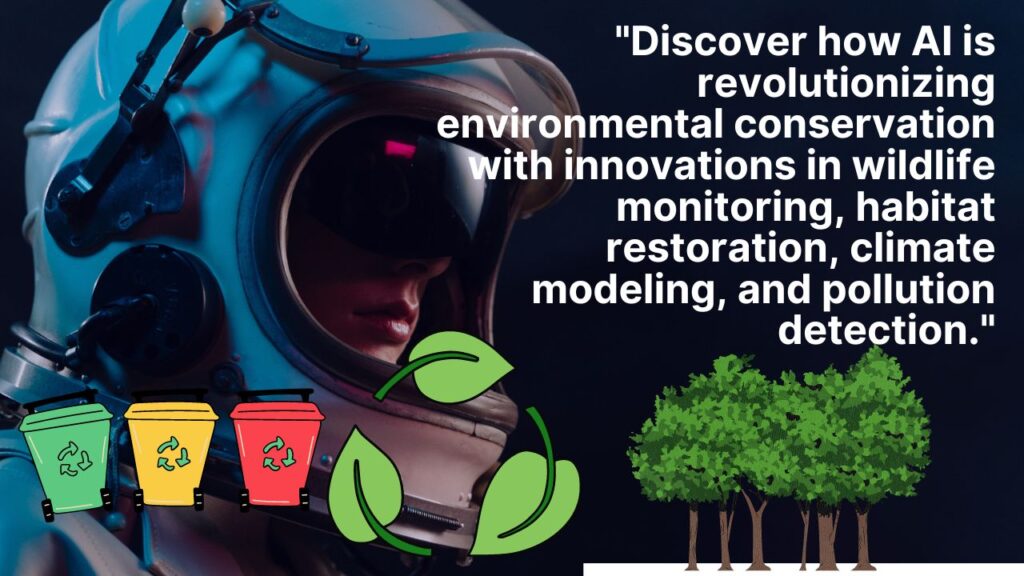
In recent years, the field of environmental conservation has been revolutionized by the integration of Artificial Intelligence (AI) technologies. From monitoring wildlife populations to predicting climate change impacts, AI is playing a crucial role in helping conservationists better understand, manage, and protect our planet’s natural resources. This article explores the diverse applications of AI in environmental conservation, highlighting its potential to address pressing environmental challenges and pave the way for a more sustainable future.
Introduction: The Importance of Environmental Conservation
Environmental conservation is essential for maintaining biodiversity, preserving ecosystem services, and ensuring the well-being of both humans and wildlife. However, the increasing pace of human activities, such as deforestation, pollution, and climate change, has put immense pressure on natural ecosystems around the world. To address these challenges, conservationists are turning to innovative technologies, including AI, to enhance their ability to monitor, manage, and protect the environment.
AI-Powered Wildlife Monitoring
One of the key applications of AI in environmental conservation is in the monitoring of wildlife populations. Traditional methods of wildlife monitoring, such as camera traps and field surveys, can be labor-intensive, time-consuming, and costly. AI technologies, such as computer vision and machine learning, are making it possible to analyze vast amounts of data from remote sensors and cameras, allowing conservationists to track animal movements, population trends, and habitat use more efficiently and accurately. By automating the process of wildlife monitoring, AI is helping conservationists gain insights into species distributions, behaviors, and interactions, which can inform conservation strategies and management decisions.
AI in Habitat Restoration and Management
AI is also being used to enhance habitat restoration and management efforts, helping conservationists restore degraded ecosystems and create more resilient habitats for wildlife. For example, AI algorithms can analyze satellite imagery and other remote sensing data to identify areas of habitat loss or degradation and prioritize restoration efforts. Additionally, AI-powered models can simulate the effects of different management strategies, such as controlled burns or invasive species removal, to optimize conservation outcomes and minimize negative impacts on ecosystems. By harnessing the power of AI, conservationists can make more informed decisions about where and how to allocate resources for habitat restoration and management, maximizing the effectiveness of conservation efforts.
AI for Climate Modeling and Prediction
Climate change poses a significant threat to global biodiversity and ecosystem stability, making it essential for conservationists to understand and predict its impacts. AI is playing a crucial role in climate modeling and prediction, helping scientists analyze complex climate data, identify patterns and trends, and make more accurate projections about future climate scenarios. AI-powered models can integrate data from various sources, such as satellite observations, weather stations, and climate simulations, to improve our understanding of climate dynamics and predict how ecosystems and species will respond to changing environmental conditions. By providing more accurate and reliable predictions, AI is helping conservationists develop proactive strategies to mitigate the impacts of climate change on biodiversity and ecosystem services.
AI for Pollution Detection and Monitoring
Pollution poses a significant threat to environmental health and biodiversity, making it essential for conservationists to monitor and mitigate its impacts. AI technologies are being used to detect and monitor pollution in various environmental media, including air, water, and soil. For example, AI algorithms can analyze satellite imagery and sensor data to identify sources of pollution, track pollutant concentrations over time, and assess the extent of environmental contamination. Additionally, AI-powered sensors and monitoring devices can detect pollutants in real-time, providing timely information to decision-makers and stakeholders. By leveraging AI for pollution detection and monitoring, conservationists can identify areas of concern, prioritize remediation efforts, and track the effectiveness of pollution control measures.
Ethical and Social Considerations
While the potential benefits of AI in environmental conservation are significant, there are also ethical and social considerations that must be addressed to ensure responsible and equitable deployment of AI-powered technologies. Concerns have been raised about the potential for bias and discrimination in AI algorithms, particularly in areas such as wildlife monitoring and habitat management. Additionally, there are questions about data privacy and security, as well as the impact of AI on local communities and indigenous peoples. It is essential for conservationists, policymakers, and technology developers to work together to address these concerns and ensure that AI is deployed in a manner that respects environmental ethics, human rights, and social justice.
Future Directions and Conclusion
Looking ahead, the future of AI in environmental conservation holds immense promise, with continued advancements in AI-driven technologies expected to further enhance our ability to monitor, manage, and protect the environment. By harnessing the power of AI, conservationists can gain new insights into ecological processes, identify emerging threats to biodiversity, and develop innovative strategies for conservation and sustainability. However, it is essential to approach the integration of AI in environmental conservation with caution, ensuring that ethical, legal, and social considerations are carefully considered and addressed. With thoughtful planning and collaboration, AI has the potential to revolutionize environmental conservation and help build a more sustainable future for generations to come.






